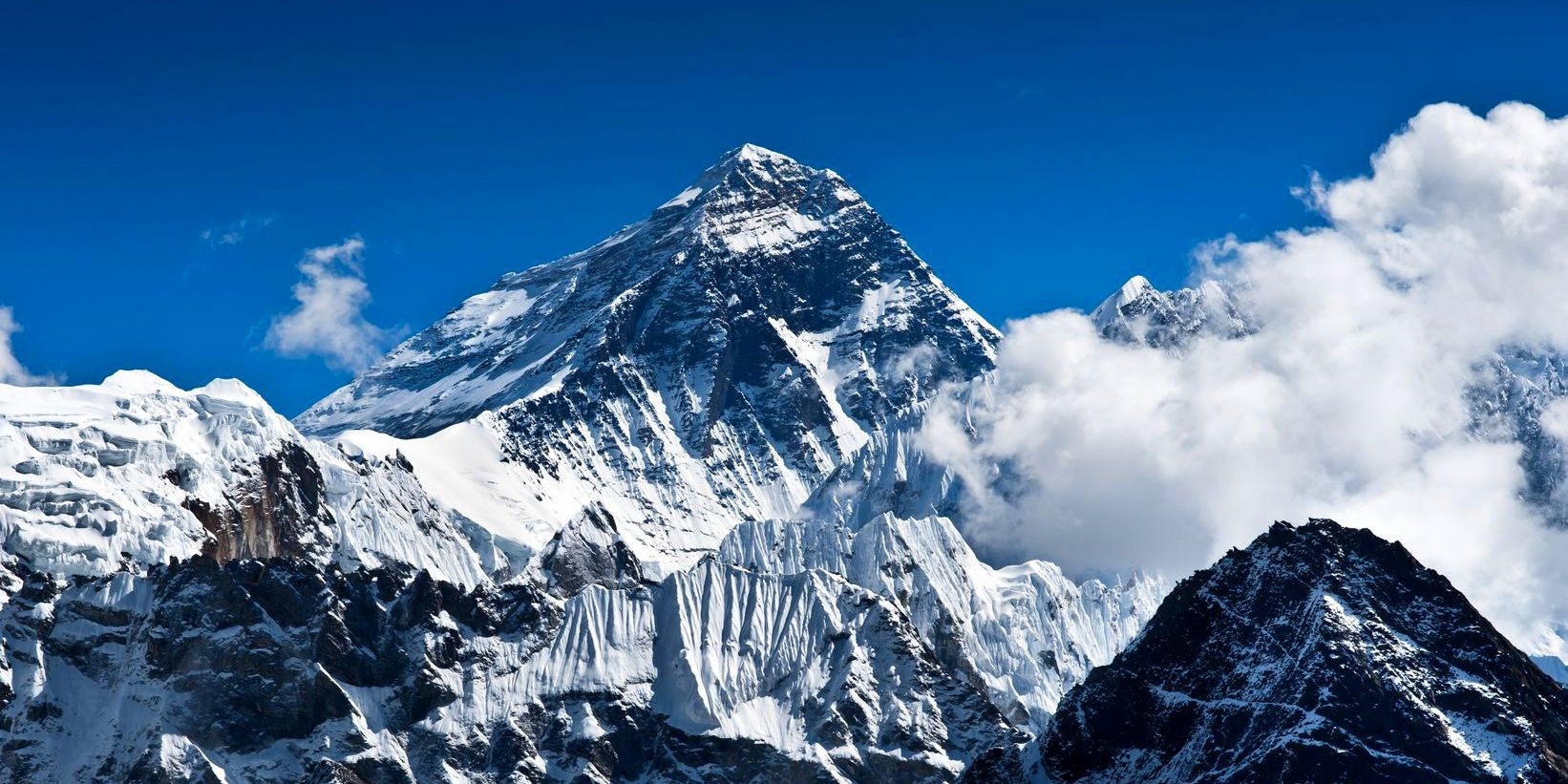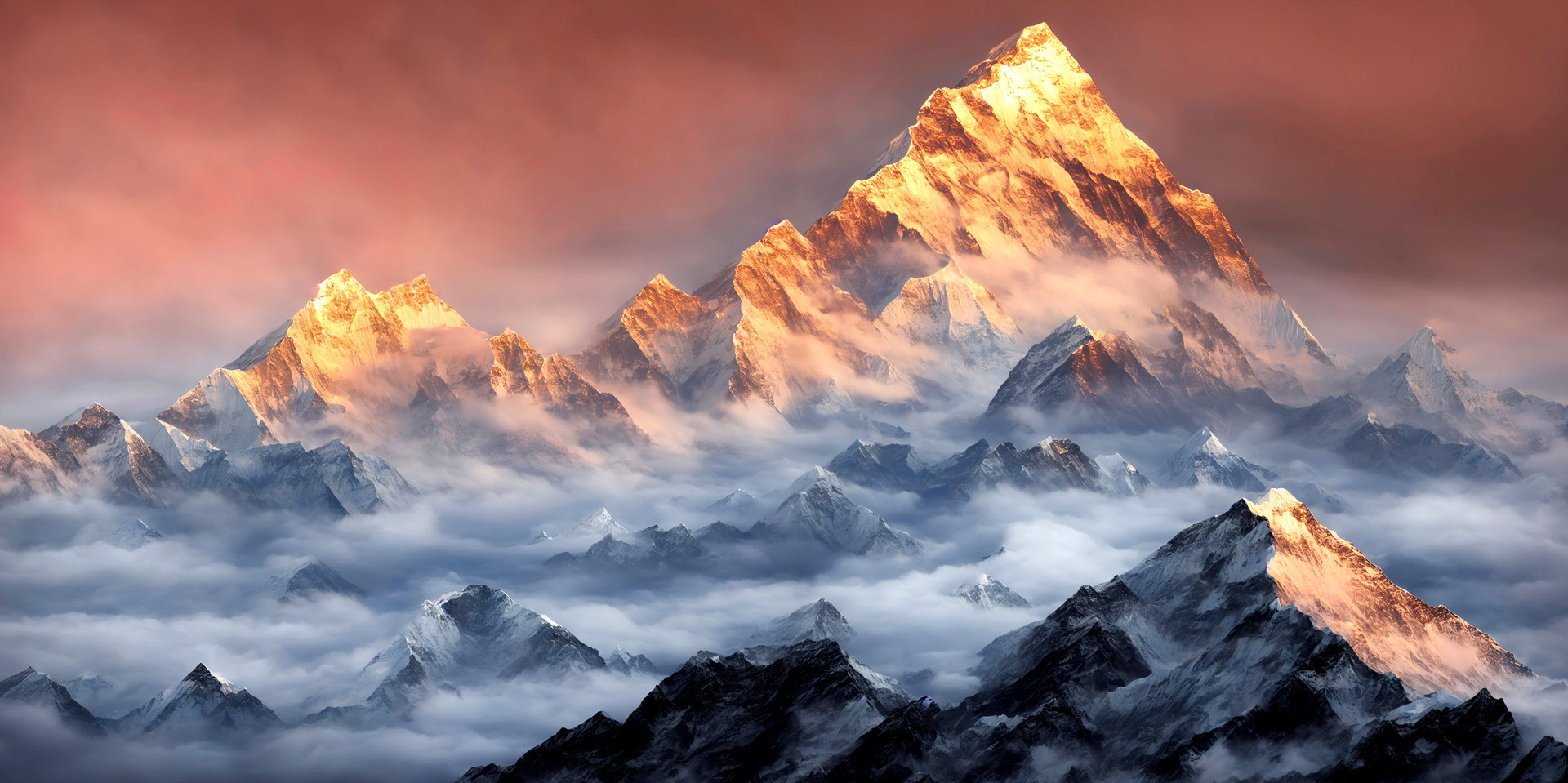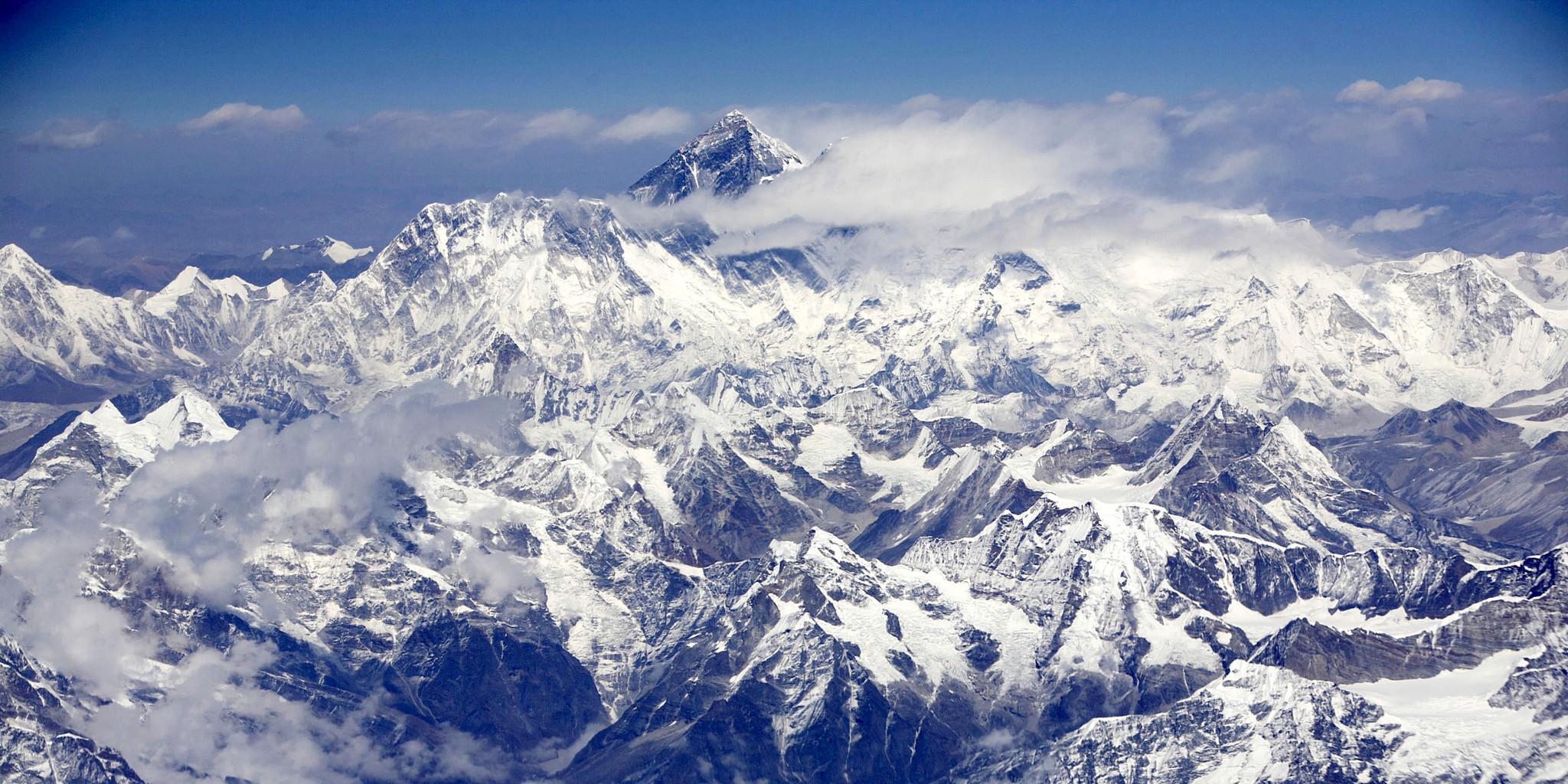Highest Point on Earth

The title "Highest Point on Earth" is held by Mount Everest, which is renowned as the tallest mountain above sea level. Located in the Himalayas, on the border between Nepal and the Tibet Autonomous Region of China, Mount Everest reaches a staggering height of approximately 8,848 metres (29,029 feet). This extraordinary elevation makes it the highest point on our planet, towering above all other peaks and mountains.
Mount Everest's elevation was first officially recognised in the mid-19th century and has been subject to various measurements over the years, with slight variations in its reported height. The mountain continues to draw mountaineers from around the globe who are eager to scale its heights and stand atop the highest point on Earth, a feat that represents one of the ultimate challenges in the world of climbing and adventure.
First Successful Ascent
The first successful ascent of Mount Everest, the highest peak on Earth, was achieved on May 29, 1953. This historic feat was accomplished by Sir Edmund Hillary from New Zealand and Tenzing Norgay, a Sherpa from Nepal. Their successful climb marked a significant milestone in mountaineering history and turned them into global icons.
The expedition that led to this achievement was organized by the British and was led by Colonel John Hunt. Hillary and Norgay were part of a larger team, but they were the first to reach the summit. They ascended via the South Col route, which has since become one of the two main routes to the summit.
Their ascent was not just a triumph of human endurance and courage but also of teamwork and international collaboration. The achievement was celebrated worldwide and is still remembered as a symbol of human determination and the spirit of adventure.
Sir Edmund Hillary and Tenzing Norgay's ascent of Everest had a lasting impact on mountaineering, opening the door for future climbers and setting a new bar for high-altitude climbing. Their legacy continues to inspire climbers and adventurers around the globe.
Geological Wonder
Mount Everest is not just the highest point on Earth; it is also a remarkable geological wonder. This majestic mountain is a part of the Himalayan mountain range in Asia, lying on the border between Nepal and the Tibet Autonomous Region of China. Here are some key geological aspects that contribute to its wonder:
-
Tectonic Activity: The formation of Mount Everest and the Himalayas is a result of the tectonic collision between the Indian Plate and the Eurasian Plate. This collision, which began about 50 million years ago, continues to this day, causing the Himalayas, and Everest in particular, to rise slightly each year.
-
Elevation Increase: Due to the ongoing tectonic activity, Mount Everest is still growing. It's estimated to be rising at a rate of about a few millimetres per year. This continuous uplift is a dynamic reminder of our planet's ever-changing nature.
-
Geological Composition: The mountain primarily consists of sedimentary and metamorphic rocks. The summit of Everest is made of limestone and marble, which were once part of an ancient seabed.
-
Glaciers and Icefalls: Everest is also known for its glaciers and icefalls, like the Khumbu Glacier. Glaciers play a crucial role in the mountain's ecology and are a source of fresh water for the valleys below.
-
Unique Challenges: The geological features of Everest, such as the Khumbu Icefall and the Lhotse Face, present unique challenges to climbers, making ascents both dangerous and demanding.
This combination of tectonic forces, geological composition, and dynamic change makes Mount Everest not only a mountaineering challenge but also a fascinating subject for geological study, showcasing the dynamic processes that shape our Earth.
Deadly Challenges
Mount Everest, despite its allure and majesty, presents a host of deadly challenges to those who attempt to climb it. These challenges are a significant reason why summiting Everest is considered one of the most difficult feats in mountaineering. Some of the key challenges include:
-
Extreme Altitude: The extreme altitude of Everest poses the greatest threat. As climbers ascend, the air becomes thinner, and oxygen levels decrease drastically. This can lead to altitude sickness, which, in severe cases, can be fatal.
-
The Death Zone: Above 8,000 metres (26,247 feet), Everest enters what is known as the "Death Zone." In this zone, oxygen is so scarce that it cannot sustain human life for extended periods of time. Prolonged exposure can lead to severe physical deterioration, impaired judgement, and, if not managed properly, death.
-
Harsh Weather Conditions: The weather on Everest is notoriously unpredictable and harsh. Climbers face extreme cold, with temperatures often dropping below -30°C (-22°F). High winds and sudden storms can further exacerbate these conditions, increasing the risk of frostbite and hypothermia.
-
Avalanches and Icefalls: The routes to Everest's summit are fraught with the dangers of avalanches and unstable ice formations like seracs. One of the most treacherous sections is the Khumbu Icefall, known for its shifting ice and deep crevasses.
-
Physical and Mental Strain: The combination of physical exertion, extreme conditions, and high altitude can take a significant toll on climbers' mental and physical health. Exhaustion, dehydration, and the effects of altitude can impair judgement and decision-making, leading to potentially fatal mistakes.
-
Overcrowding: In recent years, overcrowding on Everest has become a significant issue. Too many climbers attempting to summit in a narrow window of favourable weather can lead to dangerous bottlenecks, especially near the summit, increasing the risk of accidents and exposure to harsh conditions.
These deadly challenges make climbing Mount Everest a highly risky endeavour, requiring thorough preparation, acclimatisation, and respect for the mountain's extreme conditions.
Mount Everest's Name
Mount Everest's name has an interesting history that reflects its global significance and the era of its identification by Western explorers. Originally known to the local populations by different names, the mountain received its internationally recognised name, "Mount Everest," in the mid-19th century. Here's a brief overview:

Local Names
-
In Nepal, the mountain is known as "Sagarmatha," which roughly translates to "Forehead in the Sky" or "Goddess of the Sky."
-
In Tibet and China, it is called "Chomolungma" or "Qomolangma," meaning "Mother Goddess of the Universe."
Western Naming
- The name "Mount Everest" was bestowed upon it by the Western world in 1865. It was named after Sir George Everest, the British Surveyor General of India from 1830 to 1843. Sir George Everest himself had actually objected to this, as he argued that the local names should be used.
Survey and Identification
- The naming occurred as part of the Great Trigonometrical Survey of India, which aimed to map the Indian subcontinent. During the survey, Peak XV, as it was then known, was identified as the world’s highest peak. It was later renamed as Mount Everest.
Contemporary Recognition
- Today, both the names "Sagarmatha" and "Chomolungma" are widely recognised and used, especially in Nepal and Tibet, respectively. However, "Mount Everest" remains the most commonly used name internationally.
The naming of Mount Everest is a testament to its standing as a symbol of natural majesty and exploration, bridging different cultures and histories. The mountain's various names reflect its importance and reverence in different traditions and societies.
Climbing Routes
Climbing Mount Everest is a formidable endeavour, and there are two main routes that most climbers use to reach the summit. Each route presents its own unique challenges and characteristics.
The South Col Route
-
Location: This route is located on the Nepalese side of Everest.
-
Popularity: It is the more popular of the two main routes, partly because it is considered to be less technically challenging.
-
Key Features: The route includes famous landmarks like the Khumbu Icefall, Western Cwm, and the Lhotse Face. Climbers also have to navigate through the "Death Zone" above Camp IV.
-
Historical Significance: The South Col Route was the path taken by Sir Edmund Hillary and Tenzing Norgay during their historic first ascent in 1953.
The North Ridge Route
-
Location: This route approaches the summit from the Tibetan side.
-
Challenges: It is generally considered more challenging than the South Col Route, with more difficult weather conditions and a higher starting altitude, which can make acclimatisation tougher.
-
Key Features: Significant features of this route include the treacherous North Col, the Northeast Ridge, and the "Second Step" – a nearly vertical rock face that is one of the most difficult sections of the climb.
-
Historical Aspect: This route was first attempted by George Mallory and Andrew Irvine in 1924 during the British Mount Everest Expedition.
Both routes require climbers to be in excellent physical condition, have high-altitude climbing experience, and be well-acquainted with the use of climbing equipment. Despite the inherent dangers and challenges, these routes continue to attract climbers from around the world, drawn by the allure of reaching the top of the highest point on Earth.
Environmental Concerns
Mount Everest, while a symbol of natural majesty and human achievement, faces significant environmental concerns. The increasing popularity of Everest expeditions has brought a range of environmental challenges that threaten the ecology of this iconic region. Some of the primary concerns include:
-
Waste Management: One of the most pressing issues is the accumulation of waste. Climbers leave behind a significant amount of garbage, including used oxygen canisters, food packaging, and camping equipment. Human waste is also a major problem, as it can contaminate water sources and impact the fragile mountain ecosystem.
-
Glacial Retreat and Climate Change: The Himalayan region is witnessing rapid glacial retreat, attributed to global climate change. This not only affects water supplies downstream but also increases the risk of glacial lake outburst floods. The changing climate can also make climbing more dangerous due to unpredictable weather and increased avalanche risk.
-
Deforestation and Habitat Loss: The demand for firewood and infrastructure to support climbing expeditions has led to deforestation in the area, which in turn affects local wildlife habitats.
-
Impact on Local Communities: The influx of climbers and tourists impacts the local communities. While it brings economic benefits, it also strains local resources and can lead to cultural disruption.
-
Overcrowding: Overcrowding, especially during the climbing season, exacerbates these environmental issues. The large number of climbers can lead to increased waste, higher risks of accidents, and greater pressure on the natural environment.
In response to these challenges, various measures are being implemented and proposed, such as stricter waste management policies, regulations to control the number of climbers, and initiatives to clean up the mountain. Sustainable and responsible mountaineering practices are being encouraged to preserve the beauty and integrity of Mount Everest for future generations.
Unique Wildlife
Mount Everest and its surrounding regions are home to a unique and diverse range of wildlife, adapted to thrive in the harsh and varying climatic conditions of the Himalayas. This area, despite its extreme environment, supports a variety of species that are specialised to live at high altitudes. Some of the unique wildlife found in the Everest region includes:
-
Snow Leopard: Perhaps the most iconic species of the region, the elusive snow leopard is a high-altitude predator known for its beautiful fur and remarkable adaptability to the cold, rugged mountain terrain.
-
Himalayan Tahr: A large ungulate, the Himalayan tahr is well-adapted to life on the steep rocky slopes. It has a thick, woolly coat to withstand the cold.
-
Red Panda: This small mammal is known for its distinctive reddish-brown fur and bushy tail. The red panda is found in the temperate forests of the lower Himalayan region and is listed as endangered due to habitat loss and fragmentation.
-
Himalayan Monal: The national bird of Nepal, this pheasant is known for its vibrant and iridescent plumage. The male, in particular, displays a rainbow of colours.
-
Himalayan Black Bear: Found in the lower forested slopes, this bear is distinguished by its black fur and a white patch on its chest.
-
Musk Deer: Known for the musk it produces, which is highly valued as a perfume base, the musk deer inhabits the Himalayan region's hilly, forested environments.
-
Danphe, or Impeyan Pheasant, is another spectacular bird of the region, known for its bright and colourful feathers. It's also known as the Himalayan monal and is Nepal's national bird.
-
Yak: Although mostly domesticated, yaks are an integral part of life in the high Himalayas. These large, long-haired bovines are used as pack animals and are well-suited to low oxygen levels.
The Everest region's ecosystem is fragile, and many of these species are under threat due to habitat loss, climate change, and human activities. Conservation efforts are crucial to protecting these unique creatures and their habitats in this extraordinary environment.
Cultural Significance
Mount Everest holds immense cultural significance, particularly for the communities living in its vicinity in Nepal and Tibet. This majestic peak is not just a geographical landmark but also a symbol of spiritual and cultural importance. Here’s a deeper look into the cultural significance of Mount Everest:
-
Sherpa and Tibetan Beliefs: For the Sherpa people and Tibetans, Mount Everest, or "Chomolungma" in Tibetan, meaning "Mother Goddess of the Universe," is sacred. They believe the mountain is the abode of deities and should be treated with the utmost respect.
-
Religious Significance: In both Buddhist and Hindu traditions found in the region, mountains are often revered as the homes of gods and goddesses. Everest, due to its grandeur and height, holds a special place in these beliefs.
-
Local Traditions and Practices: Sherpas, known for their exceptional mountaineering skills, have a deep respect for the mountain and often perform religious ceremonies before embarking on climbing expeditions. These ceremonies, such as the Puja ceremony, are conducted to seek permission and blessings from the mountain deities for a safe journey.
-
Cultural Identity: Mount Everest is a symbol of national pride for Nepal and Tibet. It plays a crucial role in their cultural identity, showcasing the resilience and strength of the local communities living in harsh mountainous environments.
-
Myths and Legends: The mountain is enveloped in various local myths and legends, adding to its mystique and allure. These stories are a significant part of the oral history and folklore of the Himalayan people.
-
Tourism and Cultural Exchange: The allure of Everest has brought climbers and tourists from around the world to Nepal and Tibet, leading to a cultural exchange. This has impacted the local culture, bringing economic benefits but also challenges in preserving traditional ways of life.
-
Inspiration for Arts and Literature: Everest has inspired countless works of art, literature, and films, capturing the imagination of people globally and spreading awareness of the region's culture and traditions.
Mount Everest is much more than just the highest peak in the world; it is a symbol deeply interwoven with the cultural and spiritual fabric of the Himalayan people. This cultural significance adds to the mountain's mystique and allure, making it a site of global cultural heritage.
Record-Breaking Mountain
Mount Everest, beyond being the world's highest peak, is also a record-breaking mountain in various aspects. Its exceptional height and unique location have made it the centre of numerous world records and extraordinary achievements. Here are some key points that highlight Everest as a record-breaking mountain:
-
Highest Point on Earth: Everest holds the record for the highest altitude above sea level at approximately 8,848 meters (29,029 feet). This makes it the ultimate challenge for mountaineers.
-
First Successful Ascent Record: The first successful ascent in 1953 by Sir Edmund Hillary and Tenzing Norgay set a monumental record in mountaineering history.
-
Altitude-Related Records: Everest has been the site for various altitude-related records, such as the highest-altitude skydive and the highest-altitude marathon.
-
Youngest and Oldest Climbers: The mountain has seen records for both the youngest person to reach the summit (Jordan Romero, aged 13, in 2010) and the oldest (Yuichiro Miura, aged 80, in 2013).
-
Rapid Ascents and Descents: Everest has also been the setting for records in the fastest ascents and descents, testing the limits of human endurance and speed.
-
Most Ascents by an Individual: Apa Sherpa and Phurba Tashi Sherpa, both from Nepal, have reached the summit multiple times, holding the record for the most ascents of Everest.
-
Mountaineering Feats: Numerous climbers have set records for completing the climb without supplemental oxygen, showcasing extraordinary human endurance.
-
Paragliding and BASE Jumping: Everest has been the launch site for extreme sports records, including paragliding off the summit and BASE jumping.
These records are not just a testament to Everest's physical extremity but also to human ambition and the desire to push boundaries. As a record-breaking mountain, Everest continues to inspire and challenge people from around the world, symbolising the ultimate test of human ability and the spirit of adventure.
10 Most Interesting Facts about Mount Everest" reveal much more than just statistics about the world's highest peak. They uncover a story of geological marvels, human perseverance, and cultural significance. From its formation through the collision of tectonic plates to the challenges and triumphs of those who have dared to scale its heights, Everest stands as a testament to the awe-inspiring power of nature. The mountain's unique ecosystem, rich in rare wildlife, and its deep spiritual importance to local communities add layers of complexity to its already formidable presence. While environmental concerns and the impacts of modern expeditions highlight the need for sustainable practices, the continued fascination with Everest underscores its enduring allure. This majestic peak is not just a geographical landmark; it's a symbol of human ambition, natural beauty, and the interconnectedness of our world. As we delve into these fascinating facts, we gain not just knowledge about a mountain but also insights into our planet's history, the resilience of life, and the depth of the human spirit.
For the Nepal tour, please click here.
If you are looking for different kinds of Nepal Tours or Trekking Packages, feel free to contact us.



